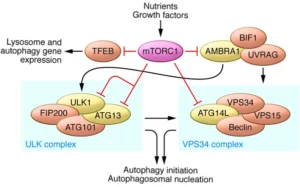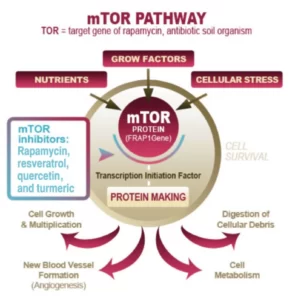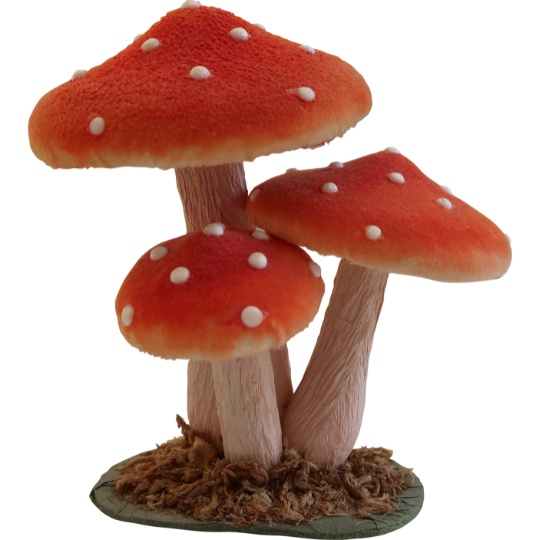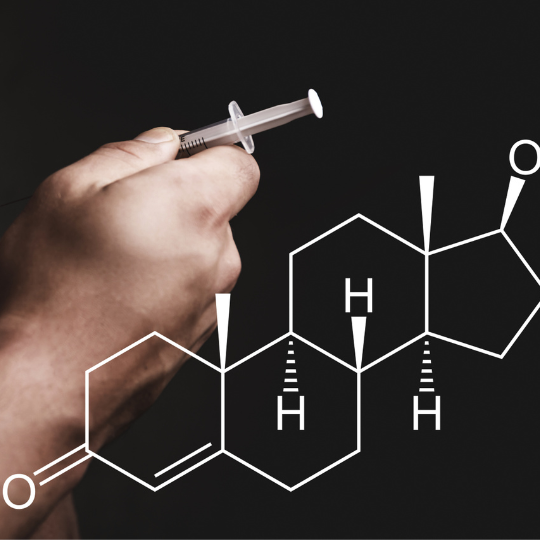The “mammalian Target of Rapamycin Pathway”, aka mTOR pathway, plays a central role in regulating cellular growth metabolism in the human body. Nutrients, growth factors, and cellular energy levels are key determinants to activate mTOR signaling pathways. mTOR forms two distinct signaling complexes: mTORC1 and mTORC2.

mTORC1 and anabolism
mTORC1 drives most anabolic processes in the cell, including protein, lipid, cholesterol, and nucleotide synthesis. mTORC1 simultaneously boosts extracellular nutrient uptake and blocks autophagic catabolism. This protein complex basically promotes cellular growth and proliferation by stimulating the synthesis of proteins and lipids.
mTORC1 is especially known because of its capacity to regulate protein synthesis. When activated, mTORC1 stimulates the synthesis of ribosomes, which are the cellular machinery responsible for synthesizing proteins. This process is essential for maintaining the structural integrity of cells and for the proper function of proteins involved in a variety of cellular processes.
In addition to its role in protein synthesis, mTORC1 also plays a central role in regulating cell’s energy metabolism. mTORC1 gets activated when there are high levels of ATP (primary energy source for cells), and it stimulates the synthesis of mitochondria, which are responsible for producing ATP. This process is essential for maintaining the energy status of the cell and for supporting its growth and proliferation.
mTORC1 vs Autophagy
Autophagy is the major cellular digestion process that removes damaged macromolecules and organelles. Autophagy is critical to providing energy and molecular building blocks by recycling macromolecules in response to nutrient and environmental stress. mTORC1 is a major regulator or autophagy.
Activation of mTORC1 by nutrients and growth factors leads to inhibition of autophagy by phosphorylation of multiple autophagy-related proteins (such as ULK1, ATG13, AMBRA1, etc.). When autophagy is inhibited, cells continue to grow and divide. Conversely, when mTORC1 is inhibited and autophagy gets activated, it leads to the degradation of damaged or unnecessary cellular components (Kim YC & Guan KL, 2015).

mTORC2 and survival
While mTORC1 plays a central role in the regulation of cellular growth and metabolism, mTORC2 has a more specialized function. It is involved in the regulation of cytoskeletal organization as well as in cell survival and proliferation.
One of the key functions of mTORC2 is its regulation of the actin cytoskeleton, which is responsible for maintaining the structural integrity of cells and allowing them to move, dance around and change their shape. When activated, mTORC2 stimulates the synthesis of actin filaments, which are proteins that provide support to the cells, giving them structure and movement.
Also, mTORC2 plays a role in cell survival and proliferation. It is activated by growth factors and promotes cell survival by activating the PI3K/Akt pathway, which regulates cell growth and division.
But why you should care about mTOR pathways you may be wondering?

Well… mTOR is crucial for you to create and produce new cells, proteins, lipids, etc. But an overstimulation of mTOR can also inhibit autophagy, and autophagy is very, very important for your cells to “reset”. Autophagy is helpful to remove cell components or even cells that are damaged and that might cause struggles in the future, for example cancer cells.
mTOR and lifestyle
Lifestyle and environmental factors can also influence mTOR activity in the body. For example, a diet high in protein and hypercaloric can stimulate mTORC1 activity, leading to increased protein synthesis and cellular growth. On the other hand, fasting and calorie restriction can inhibit mTORC1 activity and promote autophagy.

Genetics and mTOR
As always, genetics play an important role in regulating processes such as mTOR pathways. There are several SNPs that can influence mTOR activity in the human body. Here are some examples:
- FKBP5 gene: codes for a protein that regulates mTORC1 activity. Individuals with the T allele of the FKBP5 SNP have been shown to have increased mTORC2 activity, and thus, higher risk of developing diseases such as cancer and diabetes (GeneCard: FKBP5 Gene: FKBP Prolyl Isomerase 5)
- TSC1 gene: encodes a protein that inhibits mTORC1. Individuals with the C allele of the TSC1 SNP have been shown to have reduced mTORC1 activity, and thus a lower risk of developing diseases such as obesity and cardiovascular disease (GeneCard: TSC1 Gene – TSC Complex Subunit 1).
- mTOR gene: the specific polymorphisms rs2295080, rs17036508 and rs10345280 may be the susceptive factors for cancer development according to this meta-analysis.
There are other SNPs that might affect mTOR pathways, and there are simple ways in which individuals can address those genetic predispositions to ensure mTOR is functioning properly. One way is through light therapy. Exposure to bright light has been shown to inhibit mTORC2 activity and promote autophagy. Other treatments could be cold exposure, movement and breathing practices, such as yoga and meditation, which have been shown to promote cellular health and longevity.
In terms of nutrition, we have talked about fasting and calorie restriction to inhibit mTOR and activate autophagy.
Nutrition and supplementation

There are some foods that are backed up by science that may be beneficial for individuals with genetic predispositions that influence mTOR activity:
- Diets rich in fruits and vegetables, specifically those that are high in antioxidants and phytochemicals: Berries and green leafy vegetables are great examples. These foods have been shown to inhibit mTORC1 activity and promote autophagy.
- High protein diets, especially plant-based proteins may be beneficial for individuals with the T allele of the FKBP5 SNP, and may help to reduce mTORC1 activity and thus, the risk of diseases such as cancer and diabetes.
Additionally, some compounds that are recommended for the correct functioning of the mTOR pathway are:
- Rapamycin, the compound that gives mTOR pathway its name, promotes autophagy
- Curcumin, a compound found in turmeric, has anti-aging effects by the inhibition of mTORC1 activity
- Resveratrol, a compound found in red wine and known for being a powerful antioxidant and anti-aging agent.
With these recommendations we wrap up our mTOR journey. mTOR is such a powerful pathway that controls a lot of processes in the cells, and you have the power to manipulate it in your favor. We usually tackle this toward the end of our genetic and metabolic optimization approach, but it usually works wonders. Give it a go and enhance your health to live a long healthy life!













